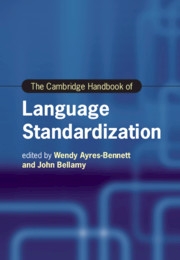Book contents
- The Cambridge Handbook of Language Standardization
- cambridge handbooks in language and linguistics
- The Cambridge Handbook of Language Standardization
- Copyright page
- Contents
- Figures
- Tables
- Contributors
- Introduction
- Part I Revisiting Models and Theories of Language Standardization
- Part II Legitimacy, Authority and the Written Form
- Part III Norms, Literacy and Education
- Part IV Beyond the National
- Part V Standardization in Late Modernity
- 25 Destandardization
- 26 Contemporary Perspectives on Language Standardization
- 27 Standardization and New Urban Vernaculars
- 28 Renegotiating Language Norms in Minority Contexts
- 29 Sign Language Standardization
- Name Index
- Subject Index
- References
26 - Contemporary Perspectives on Language Standardization
The Role of Digital and Online Technologies
from Part V - Standardization in Late Modernity
Published online by Cambridge University Press: 01 July 2021
- The Cambridge Handbook of Language Standardization
- cambridge handbooks in language and linguistics
- The Cambridge Handbook of Language Standardization
- Copyright page
- Contents
- Figures
- Tables
- Contributors
- Introduction
- Part I Revisiting Models and Theories of Language Standardization
- Part II Legitimacy, Authority and the Written Form
- Part III Norms, Literacy and Education
- Part IV Beyond the National
- Part V Standardization in Late Modernity
- 25 Destandardization
- 26 Contemporary Perspectives on Language Standardization
- 27 Standardization and New Urban Vernaculars
- 28 Renegotiating Language Norms in Minority Contexts
- 29 Sign Language Standardization
- Name Index
- Subject Index
- References
Summary
There is plenty of evidence indicating that the rise in usage and influence of digital and online forms of communication is having an effect on language norms and processes of standardization. Some examples are the shifts in writing norms in digital spaces, the diversification of language norm authorities and the impact of crowdsourcing on dictionaries and reference works. Whereas existing research has predominantly centred on the consequences of digital and online technologies for developments ‘from below’, this chapter focuses instead on their significance for standardization and policies ‘from above’. With reference to the most recent official revisions to the Luxembourgish language orthography, the chapter examines efforts by state institutions and private organizations to implement language standards and create greater awareness of written norms for Luxembourgish. The analysis encompasses the Schreiwen.lu online resources and spelling campaign, digital Luxembourigish dictionaries and spellcheckers, as well as the rtl.lu online news platform. The findings indicate that such technological developments enable multiple approaches for creating, negotiating and disseminating language standards. Online and digital media not only affect bottom-up language practices, but also have an increasingly influential role in the norm implementation and standardization effected by the state and by private entities.
- Type
- Chapter
- Information
- The Cambridge Handbook of Language Standardization , pp. 691 - 712Publisher: Cambridge University PressPrint publication year: 2021
References
- 1
- Cited by



